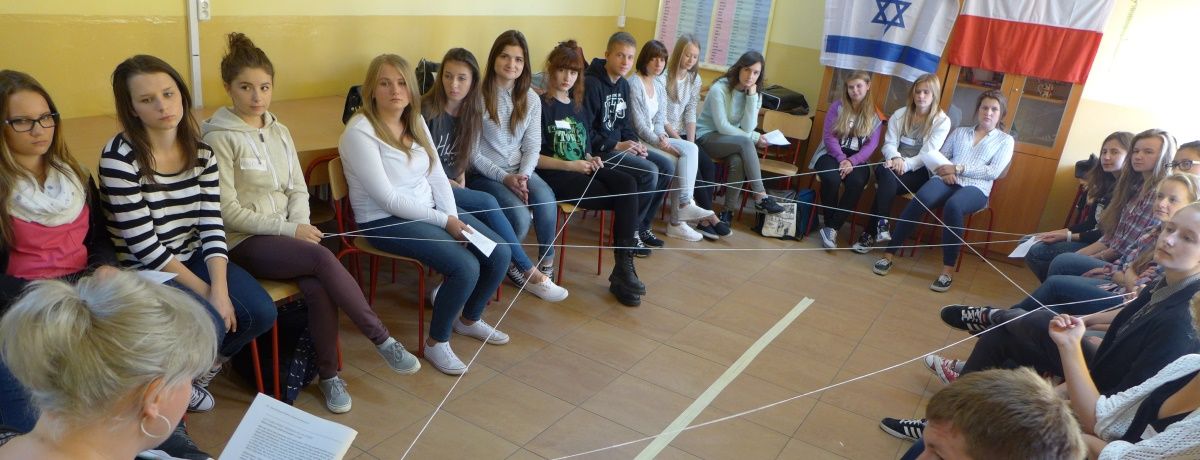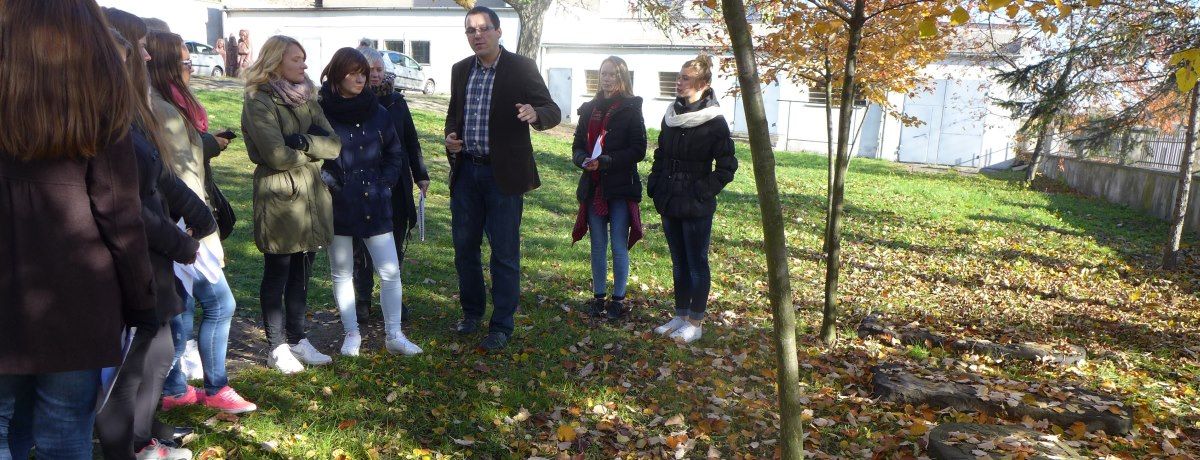| 2015 |
Opoczno
Stefan Żeromski High School No 1


| 2015 |
Finalist at 2015 School of Dialogue Gala
Opoczno is located between Łódź and Radom. This small town was Jewish in 50% before World War II. This is why Forum for Dialogue educators Dorota Cieślik and Beata Godlewska introduced Opoczno high school students to Judaism, Jewish culture and history of the local Jewish community and the Holocaust in Opoczno; the rest was done by students themselves. Forum educators showed them certain things, helped identify certain facts and understand certain matters; the students took care of the rest.
They met with the town’s mayor to talk about what they can and want to achieve. Dominika and Michał suggested creating a mural with some references to Jewish culture. The mayor gave his approval, so students began to search for assistance. In their search for information that would help them create a tour of Jewish Opoczno, some of the girls headed to the regional museum, where they received books and resources and one of the employees told them everything she knew.
First mentions of Opoczno’s Jews come from the beginning of the 16th century (1501), but in all likelihood Jews had already lived there earlier. Later on, Jews were expelled from the town as a result of de non tolerandis Judaeis privilege, to return less than a century later. This is when the community built a synagogue, opened a cemetery and later on a mikveh. Over time, Opoczno became a Christian and a Jewish town, divided along religious lines. Jews were merchants, artisans, bakers and innkeepers. They were also tailors, furriers and tinsmiths. The town was home to Rozenblatts’s brick plant, Dziewulski&Lange china manufacture, limestone mines and ovens made by Tyktin, Goldberg and Rozenblatt. In the 19th century, Jews comprised 57% of the town’s population. The Jewish community already had two cemeteries, a mikveh, a cheder and a synagogue. Some were Hassidic Jews. In the 20th century, Maccabee, Hapoel and Kraft clubs all operated in Opoczno, Association of Jewish Working Youth, Linas Hatzedek Association and a few other charity organizations also existed in the town. Jews had their representatives in the local authorities, with Zionists and Hassidim vying for seats in the Town Council. In 1937, Opoczno had ca.3400 Jewish residents – or around 714 families.
Opoczno’s ghetto was created in November or December 1940 in the area between PIłsudskiego, Błotna, Kazimierza Wielkiego and Berka Joselewicza Streets.
It was partly isolated from the rest of the town and became home to ca.7000 Jews, who either worked in the peat mine or in work camps. A Judenrat was created, with its headquarters at the corner of 1 Maja and Janasa Streets. Mordechaj Rosenbaum became the head of the Judenrat. Meanwhile, typhus epidemic broke out twice in the ghetto. On October 27, 1942, Germans proceeded to liquidate the ghetto – circa 3000 Jews were sent to Treblinka. Those who managed to escape became partisans. Around 200 Jews were murdered by Germans at the cemetery at Limanowskiego Street. Another 300 were killed at 17 stycznia Street, once known as Grobelna Street. 25 victims of the execution organized by Germans in 1943 lay in a mass grave at Opoczno’s World War II Victims’ Cemetery (Cmentarz Ofiar II Wojny Światowej). The 500 people that remained in the ghetto were taken to a transit camp in Ujazd and then to Treblinka.
The synagogue at 13 Janasa Street was plundered after the war. It used to be a movie theater called “Tęcza” (“The Rainbow”), now it is home to a window factory. Right next door stands the building of a former mikveh, which now serves residential purposes. Stary Targ (“Old Market”), which used to be the commercial hub of Opoczno as well as the heart of the Jewish district, is now overgrown with grass. Then at Zajazdowa Street (former Joselewicza Street) stands a stone tenement house. This used to be the rabbi’s house. At the corner of Szpitalna and Cicha Streets, the Kehila building still stands.
Four Jewish cemeteries used to exist in the town. The oldest one at 20 17 stycznia Street functioned until 1646. The second one, known as “the new Jewish cemetery”, is located at 23 Limanowskiego Street and is the only Jewish cemetery with some headstones still in place. A fragment of the cemetery wall still stands. The cemetery created in 1646 is located at Janasa Street, not far from the synagogue. The cemetery created shortly before the war, in the area of present-day Słoneczna and Partyzantów Streets, has been built over with apartment blocks. What remains from the cemetery is the well and the caretaker’s house. Recently an indentation made by a mezuzah was discovered in a doorframe of one of the houses at Dworcowa Street. At the same time, one of the villages nearby Opoczno is still home to Stanisław Wróbel, who provided shelter to a Jewish family during World War II – first in a barn and later in a hiding place under the barn. His whole family received the title of Righteous Among Nations from Yad Vashem, and one of the survivors is still in touch with Mr. Wróbel.

In 2012, a commemorative plaque was unveiled at Kilińskiego Street to honor the Jews that had been deported to Treblinka on October 27, 1942.
Students walked around the town, talked to people and tried to understand what used to stand where, what the buildings looked like, what kind of sounds they exuded; what the streets were like, were they bustling, what the air used to smell like. A different group headed to the town’s library to meet Mr. Andrzej Śliwka, who showed them maps and explained some additional facts. The students also attended a performance organized by their peers from Tomaszów Mazowiecki – a play entitled “Letters from the Ghetto”. One of the students met with her uncle, who remembered the war and prewar times; prewar streets and wartime executions of the Jews. He told her that he herded cows close to the execution grounds, which he said were not far from the river. He also told her about deportations – that he saw Jews being led down Piotrkowska Street towards the train station: Germans with dogs in rows to left and right, Jews in the middle. He said that he saw it all, that he and his friends followed them all the way to the end, to the station.
Students also met with Ms. Sara Rosenkrantz and Dvora Sade, who visited from Israel for the promo of the “Opoczno Memory Book”. They visited, because both had family roots in Opoczno. They told students their family stories, how the past of Opoczno lives on. Students took both ladies on a walk around the town; they shared their impressions and how they see Opoczno. During the promotion of the “Opoczno Memory Book” describing the history and culture of Opoczno’s Jews, students recited “Mayn sztetele Belz”, first in Yiddish, then in Polish. They sang “Aman Minush” in ladino and “Dziwny jest ten świat” (“Strange is this world”) in Polish. There was also violin music; all in all, the meeting was very emotional. The girls talked about School of Dialogue and their experiences. Finally, at 10 am on November 7, the students began their tour – “Memorial route for Opoczno’s Jews”.
“Those who do not remember the past are condemned to repeat it” – the famous statement by philosopher and writer George Santayana was featured on posters advertising the tour, which ultimately was attended by pupils, teachers, parents, local authorities and friends.
The group visited the building of the old synagogue and the headquarters of the Judenrat. Participants walked down the streets that once were part of the ghetto and visited the site of a former cemetery, now completely invisible, as well as the Regional Museum, where the matzevot that had been salvaged by town residents are kept. The museum’s director showed tour participants a photo exhibition about Jews of Opoczno and the matzevot, which are now secured in the museum garden. He also explained how to seek and collect information about Opoczno’s Jews: what are the potential sources, how to find the needed information. At the end of the tour, its youngest participant, a little girl, asked: “Why was everything that was theirs destroyed?”
Students set up a Facebook fan page where they would regularly post information about their project work. Someone even wrote to tell them that he has a matzevah and would like to know what to do with it. A few days after the tour, on November 13, in Esterka’s House, students organized a Jewish Songs Concert. They invited other students, played and sang, in Yiddish and in Ladino. Justyna Biernat, who is Tomaszów Mazowiecki resident and PhD candidate at Jagiellonian University in Krakow, gave a short presentation about Jewish music. Students also organized a competition “Multicultural Opoczno in a Lens” to encourage photographing sites that used to be and are still somehow Jewish. The sent-in photos would be posted on their fanpage, with page followers choosing contest winners. On November 19, students led a tour of Jewish Opoczno for a group of Americans, Brits and Canadians, guests of the Forum for Dialogue. The tour was preceded by joint ice-breaking activities. The guests were very pleased, they commented on their experience for a long time afterwards and expressed their thanks.
The project ended at the same time that performative reading of “Letters from the Ghetto” was to take place. Opoczno’s students were invited to participate in this project by Tomaszów’s Informal Drama Group. The reading was accompanied by a presentation about Tomaszów’s Jewish youth under the occupation and a conversation about the letters. Opoczno students presented their own activity conducted through School of Dialogue Program. Everyone shared their experience and planned future actions.

School:
Stefan Żeromski High School No 1
Honorable Mention:
Finalist at 2015 School of Dialogue Gala
Students:
students from different grades
Teacher:
Karina Larecka
Educators:
Dorota Cieślik, Beata Godlewska
School of Dialogue program in Opoczno was made possible by the support from IRVING CHASE.
In appreciation to the Conference on Jewish Material Claims Against Germany (Claims Conference) for supporting this educational program. Through recovering the assets of the victims of the Holocaust, the Claims Conference enables organizations around the world to provide education about the Shoah and to preserve the memory of those who perished.

In appreciation to Friends of the Forum for supporting the School of Dialogue educational program.
